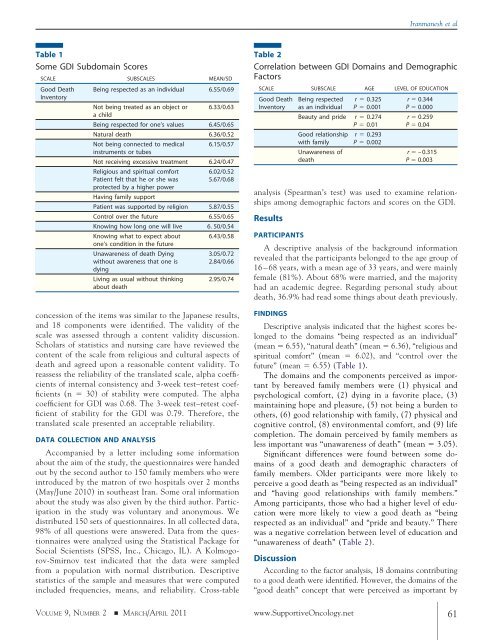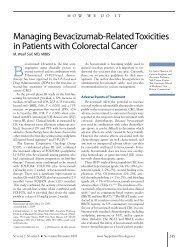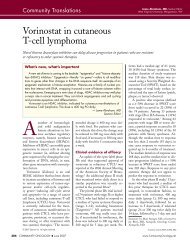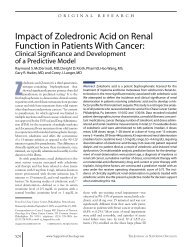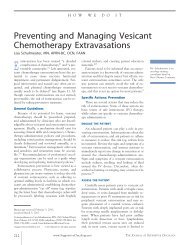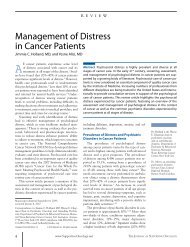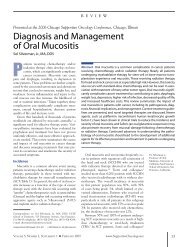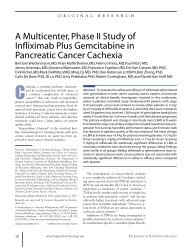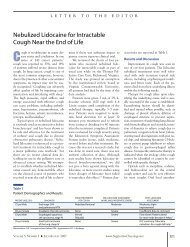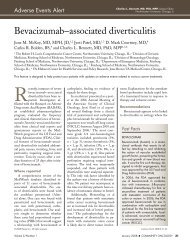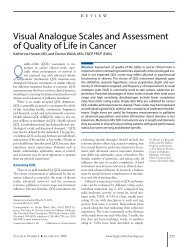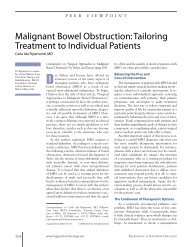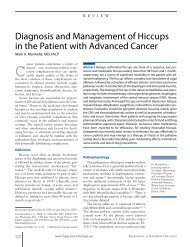Evaluating the “Good Death” Concept from Iranian Bereaved Family
Evaluating the “Good Death” Concept from Iranian Bereaved Family
Evaluating the “Good Death” Concept from Iranian Bereaved Family
Create successful ePaper yourself
Turn your PDF publications into a flip-book with our unique Google optimized e-Paper software.
Table 1<br />
Some GDI Subdomain Scores<br />
SCALE SUBSCALES MEAN/SD<br />
Good Death<br />
Inventory<br />
Being respected as an individual 6.55/0.69<br />
Not being treated as an object or<br />
a child<br />
6.33/0.63<br />
Being respected for one’s values 6.45/0.65<br />
Natural death 6.36/0.52<br />
Not being connected to medical<br />
instruments or tubes<br />
6.15/0.57<br />
Not receiving excessive treatment 6.24/0.47<br />
Religious and spiritual comfort<br />
Patient felt that he or she was<br />
protected by a higher power<br />
Having family support<br />
6.02/0.52<br />
5.67/0.68<br />
Patient was supported by religion 5.87/0.55<br />
Control over <strong>the</strong> future 6.55/0.65<br />
Knowing how long one will live 6. 50/0.54<br />
Knowing what to expect about<br />
one’s condition in <strong>the</strong> future<br />
6.43/0.58<br />
Unawareness of death Dying<br />
3.05/0.72<br />
without awareness that one is<br />
dying<br />
2.84/0.66<br />
Living as usual without thinking<br />
about death<br />
2.95/0.74<br />
concession of <strong>the</strong> items was similar to <strong>the</strong> Japanese results,<br />
and 18 components were identified. The validity of <strong>the</strong><br />
scale was assessed through a content validity discussion.<br />
Scholars of statistics and nursing care have reviewed <strong>the</strong><br />
content of <strong>the</strong> scale <strong>from</strong> religious and cultural aspects of<br />
death and agreed upon a reasonable content validity. To<br />
reassess <strong>the</strong> reliability of <strong>the</strong> translated scale, alpha coefficients<br />
of internal consistency and 3-week test–retest coefficients<br />
(n � 30) of stability were computed. The alpha<br />
coefficient for GDI was 0.68. The 3-week test–retest coefficient<br />
of stability for <strong>the</strong> GDI was 0.79. Therefore, <strong>the</strong><br />
translated scale presented an acceptable reliability.<br />
DATA COLLECTION AND ANALYSIS<br />
Accompanied by a letter including some information<br />
about <strong>the</strong> aim of <strong>the</strong> study, <strong>the</strong> questionnaires were handed<br />
out by <strong>the</strong> second author to 150 family members who were<br />
introduced by <strong>the</strong> matron of two hospitals over 2 months<br />
(May/June 2010) in sou<strong>the</strong>ast Iran. Some oral information<br />
about <strong>the</strong> study was also given by <strong>the</strong> third author. Participation<br />
in <strong>the</strong> study was voluntary and anonymous. We<br />
distributed 150 sets of questionnaires. In all collected data,<br />
98% of all questions were answered. Data <strong>from</strong> <strong>the</strong> questionnaires<br />
were analyzed using <strong>the</strong> Statistical Package for<br />
Social Scientists (SPSS, Inc., Chicago, IL). A Kolmogorov-Smirnov<br />
test indicated that <strong>the</strong> data were sampled<br />
<strong>from</strong> a population with normal distribution. Descriptive<br />
statistics of <strong>the</strong> sample and measures that were computed<br />
included frequencies, means, and reliability. Cross-table<br />
Table 2<br />
Correlation between GDI Domains and Demographic<br />
Factors<br />
SCALE SUBSCALE AGE LEVEL OF EDUCATION<br />
Good Death<br />
Inventory<br />
analysis (Spearman’s test) was used to examine relationships<br />
among demographic factors and scores on <strong>the</strong> GDI.<br />
Results<br />
Being respected<br />
as an individual<br />
r � 0.325<br />
P � 0.001<br />
Beauty and pride r � 0.274<br />
P � 0.01<br />
Good relationship<br />
with family<br />
Unawareness of<br />
death<br />
r � 0.293<br />
P � 0.002<br />
Iranmanesh et al<br />
r � 0.344<br />
P � 0.000<br />
r � 0.259<br />
P � 0.04<br />
r � –0.315<br />
P � 0.003<br />
PARTICIPANTS<br />
A descriptive analysis of <strong>the</strong> background information<br />
revealed that <strong>the</strong> participants belonged to <strong>the</strong> age group of<br />
16–68 years, with a mean age of 33 years, and were mainly<br />
female (81%). About 68% were married, and <strong>the</strong> majority<br />
had an academic degree. Regarding personal study about<br />
death, 36.9% had read some things about death previously.<br />
FINDINGS<br />
Descriptive analysis indicated that <strong>the</strong> highest scores belonged<br />
to <strong>the</strong> domains “being respected as an individual”<br />
(mean � 6.55), “natural death” (mean � 6.36), “religious and<br />
spiritual comfort” (mean � 6.02), and “control over <strong>the</strong><br />
future” (mean � 6.55) (Table 1).<br />
The domains and <strong>the</strong> components perceived as important<br />
by bereaved family members were (1) physical and<br />
psychological comfort, (2) dying in a favorite place, (3)<br />
maintaining hope and pleasure, (5) not being a burden to<br />
o<strong>the</strong>rs, (6) good relationship with family, (7) physical and<br />
cognitive control, (8) environmental comfort, and (9) life<br />
completion. The domain perceived by family members as<br />
less important was “unawareness of death” (mean � 3.05).<br />
Significant differences were found between some domains<br />
of a good death and demographic characters of<br />
family members. Older participants were more likely to<br />
perceive a good death as “being respected as an individual”<br />
and “having good relationships with family members.”<br />
Among participants, those who had a higher level of education<br />
were more likely to view a good death as “being<br />
respected as an individual” and “pride and beauty.” There<br />
was a negative correlation between level of education and<br />
“unawareness of death” (Table 2).<br />
Discussion<br />
According to <strong>the</strong> factor analysis, 18 domains contributing<br />
to a good death were identified. However, <strong>the</strong> domains of <strong>the</strong><br />
“good death” concept that were perceived as important by<br />
VOLUME 9, NUMBER 2 � MARCH/APRIL 2011 www.SupportiveOncology.net 61


